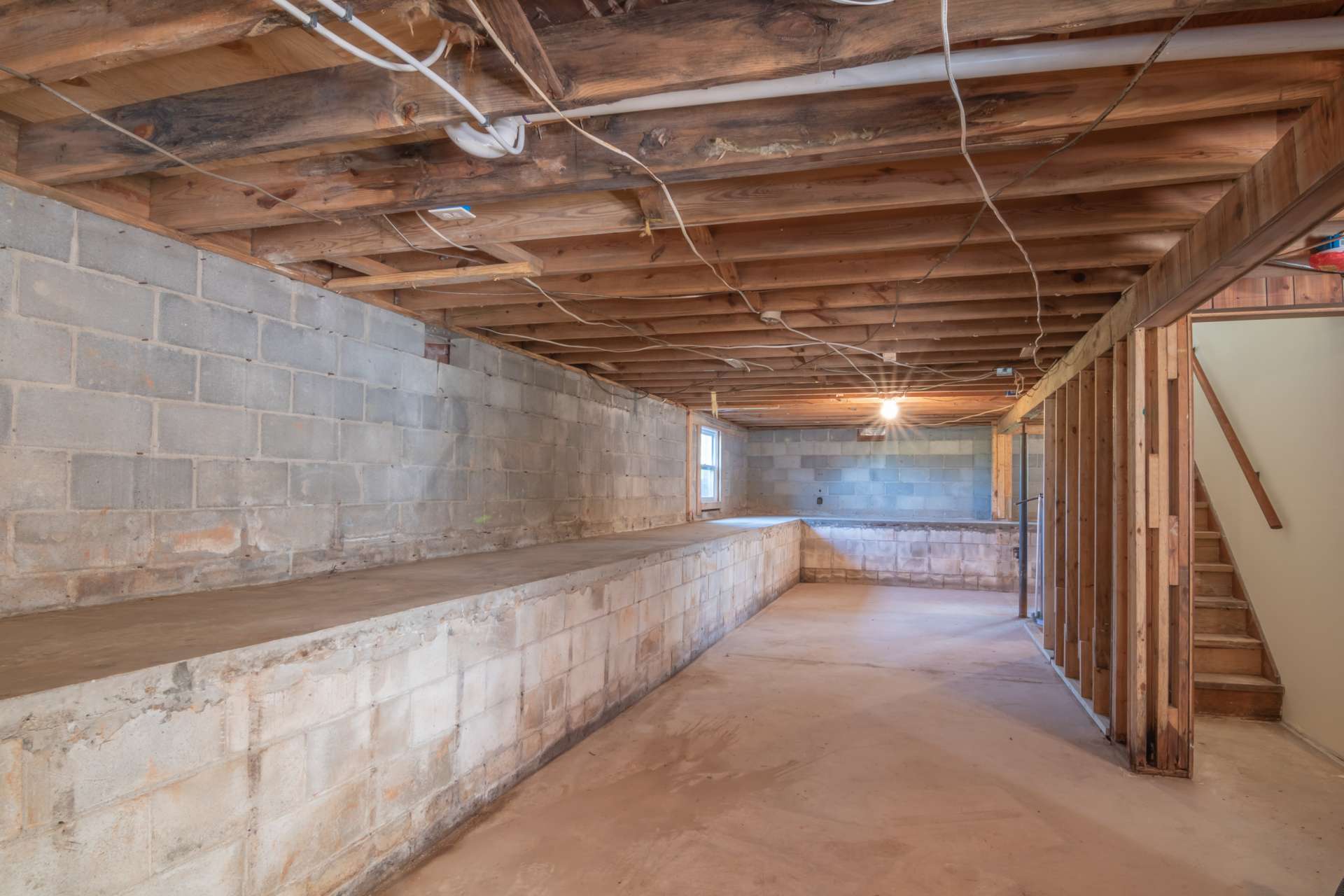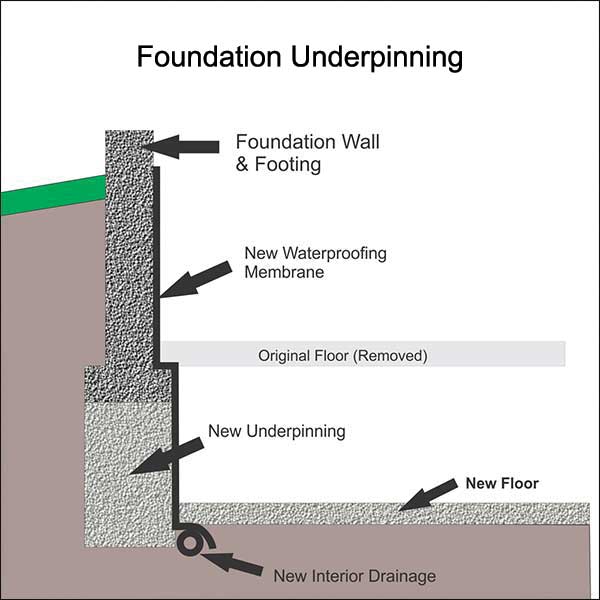Discover Quality: Toronto Basement Underpinning Services You Can Trust
Discover Quality: Toronto Basement Underpinning Services You Can Trust
Blog Article
Everything You Required to Find Out About Basement Support for a Stronger Home
Basement underpinning is a vital procedure that can considerably enhance the structural stability of a home. Whether you are considering restoring your basement or have actually seen indications of foundation problems, recognizing the ins and outs of underpinning is vital. From acknowledging the indications that your home might gain from underpinning to the costs involved and post-underpinning maintenance, this detailed guide will clarify the complexities of this building and construction method. Remain tuned to find just how cellar base can not only reinforce your home yet likewise supply satisfaction for years to come.
Advantages of Cellar Base
Cellar base uses considerable architectural reinforcement and raised stability to homes, guaranteeing long-term safety and security and resilience. One of the vital benefits of cellar underpinning is the ability to reinforce the structure of a residential property, specifically in situations where the existing foundation is deteriorated or endangered. By expanding the depth or width of the structure, underpinning disperses the weight of the building more effectively, decreasing the risk of negotiation or structural failing in time.
Moreover, basement support can produce added home or permit for the construction of a cellar in properties that do not presently have one. This can substantially enhance the worth of the home and supply even more practical space for the house owners. In addition, underpinning can aid stop water seepage and enhance the overall energy performance of the residential property by sealing splits and spaces in the structure.
Signs You Need Underpinning
Offered the structural reinforcement and security advantages that basement underpinning provides, it is vital to be mindful of particular indicators that may signify the demand for this foundational conditioning strategy. One common indicator that your home may call for underpinning is the visibility of splits in the wall surfaces, especially if they are angled or broader than a quarter of an inch. Additionally, doors or home windows that are sticking or no more closing correctly might suggest a moving foundation that needs underpinning. Irregular or sloping floors, specifically in older homes, might also recommend foundational concerns that support can attend to successfully. If you see voids in between the walls and the ceiling or in between the wall surfaces and the flooring, it can be a sign of structure settlement, motivating the demand for base. Lastly, any noticeable indicators of dampness or water damages in the basement can be an indication of a jeopardized structure that calls for underpinning to avoid additional structural damage. Frequently examining your home for these signs can assist you identify the need for underpinning early, guaranteeing the architectural stability of your home.
Process of Underpinning

To launch the procedure of support, a detailed assessment of the existing structure's condition is performed by qualified architectural engineers. This analysis includes examining the architectural honesty of the foundation, determining any kind of indicators of distress or weak point, and establishing the appropriate support method to strengthen the structure. When the assessment is complete and foundation is deemed essential, the underpinning procedure usually starts with digging deep into areas of the existing structure in a strategic manner. This excavation allows for the setup of additional assistance, such as concrete or steel beam of lights, underneath the structure to enhance its security and load-bearing capability.
After the assistance system is in location, the following action entails progressively loading the dug deep into areas with high-strength cement to protect the new foundation assistance ready. Throughout the underpinning process, cautious monitoring and changes are made to guarantee that the structure is properly enhanced and that the architectural stability of the building is maintained. By following an organized approach and adhering to sector best methods, underpinning can effectively reinforce the foundation of a home and reduce structural issues.
Expense Considerations
Thinking about the monetary implications of underpinning a cellar is crucial for property owners wanting to strengthen their home's foundation. The cost of support can vary considerably relying on numerous factors such as the dimension of the basement, the depth of the foundation called for, the present problem of the foundation, and the details underpinning method selected. Usually, homeowners can expect to pay anywhere from $1,000 to $3,000 per linear foot for underpinning solutions. This suggests that for a normal 30-foot cellar, the overall price could range from $30,000 to $90,000 - basement underpinning services toronto.
It's important for house owners to get multiple quotes from reliable underpinning specialists to ensure they are obtaining a reasonable rate for the work required. In addition, it's vital to budget plan for any type of unexpected conditions or additional expenses that might develop during the underpinning procedure. While the expense of support may seem high, it is a required financial investment to ensure the architectural stability and safety and security of the home in the long term.
Maintenance After Underpinning
Complying with the completion of basement underpinning, normal upkeep is vital to maintain the architectural improvements and ensure long-lasting stability of the continue reading this home. Once underpinning is done, home owners ought to vigilantly keep an eye on the basement for any kind of signs of fractures, water infiltration, or shifts in the structure. Normal inspections by a qualified specialist can assist catch any type of problems beforehand, avoiding possible pricey fixings in the future.
It is important to preserve proper drainage around the structure to avoid water damage. Seamless gutters ought to be kept check out this site tidy, and downspouts need to guide water far from your house. Any type of landscape design around the structure should slope far from the home to stay clear of water merging near the cellar wall surfaces.

Furthermore, maintaining consistent humidity levels within the basement is crucial to avoid moisture-related problems. Correct ventilation and using dehumidifiers can assist regulate humidity levels and shield the recently strengthened structure.
Conclusion
Finally, basement base is a valuable process for strengthening the structure of a home. By recognizing the indicators that indicate the demand for support and understanding the procedure and costs involved, homeowners can guarantee the stability and safety of their building - basement lowering toronto. Appropriate maintenance after underpinning is necessary to prolong the life-span of the foundation and prevent future concerns
One of the essential benefits of cellar foundation is the capability to enhance the structure of a property, particularly in cases where the existing foundation is damaged or compromised. As soon as the analysis is complete and underpinning is deemed needed, the underpinning process usually starts with excavating sections of the existing foundation in a strategic way. The cost of base can differ Continued significantly depending on various factors such as the dimension of the cellar, the deepness of the support called for, the existing condition of the structure, and the specific base method chosen. As soon as base is done, home owners must vigilantly keep an eye on the cellar for any kind of signs of fractures, water infiltration, or changes in the structure.In verdict, basement support is a valuable process for reinforcing the structure of a home.
Report this page